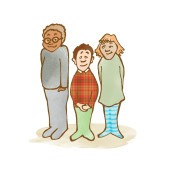How to Use the “Diversity” Stories
The words Difference and Diversity come from the same Latin root – which is to "turn aside."
When something "turns aside" something else, it becomes distinct from that original thing, it becomes clearly separate – it becomes different.
So “Diversity” is a "turning of different ways.”
I like this image of turning.
When someone turns, you can see the front, and sides, and back of them. And they, in turning, can see all around themselves.
In contrast, by standing still and only having one perspective of the world, one can become defined by that one point of view, and miss out on all the possibilities around them.
When one is open to diversity, which can be found just about everywhere, one opens themselves to see as much as possible, and invites others to truly see them. They gain understanding and in turn can be understood. They clear their minds and open their hearts to peace and understanding.
The three stories in the “Diversity” collection are about that turning: the turning of individuals toward other individuals, as well as the turning of communities toward other communities.
Below are all three of the stories in the "Diversity" collection:
This story is good for seeing how our behavior and habits are tied to stories and beliefs that we think are true for everyone. But it doesn’t take long to see that other people have VERY DIFFERENT beliefs and habits. So how to we reconcile this? How do we find common ground, or at least a way of getting along? We need to see them – from all perspectives.
This story is good for seeing how every conflict, every challenge, every opportunity, can be seen from many different perspectives. There is no right answer – and often there are as many answers as there are people offering them. So how do we make decisions? How do we know the right thing to do? Well, the last step of making the decision is a LOT easier when the first step is deeply and thoroughly taken up: listening, paying attention, and including perspectives that are different from yours.
This story is good for seeing the invented limitations that can be placed on different groups of people – limitations due to age, gender, ethnicity, religion, family of origin, race, nationality. When someone is allowed to see themselves fully – without imposed limitations – the world benefits from their uniqueness and novelty. The world becomes more diverse.
A word on listening to these stories and, for that matter, all the Helping & Healing stories:
Start by letting your child listen – without any context or coaching.
Then later that day or the following day, your child may have a question. This is the cue that they are ready to process the story with you. At that point the lemurs or judges or gnomes can serve as a starting place for a conversation about something real in their life – or an enduring question they have had.
Sometimes listening to them again or a third time is good for some children – but the stories will be much more effective if they are NOT attached to a lesson or advice.
About the Author

David Sewell McCann
David Sewell McCann fell in love with spinning stories in first grade – the day a storyteller came to his class and captured his mind and imagination. He has been engaged in storytelling all of his adult life through painting, film-making, teaching and performing. Out of his experience as a Waldorf elementary class teacher and parent, he has developed a four step method of intuitive storytelling, which he now shares through workshops and through this website.


